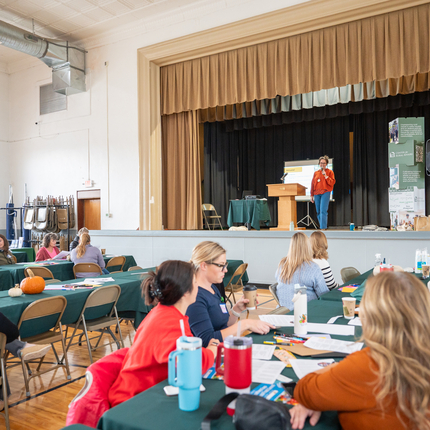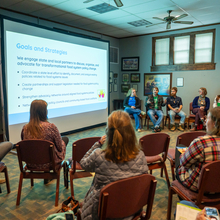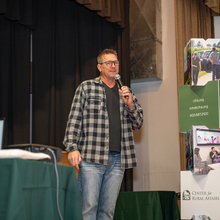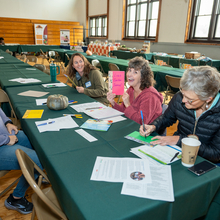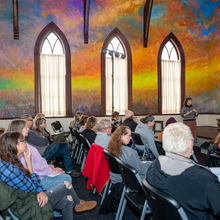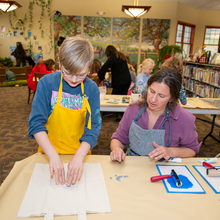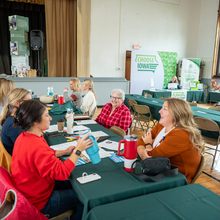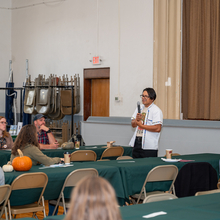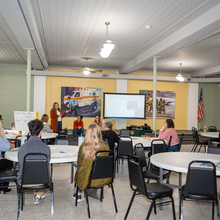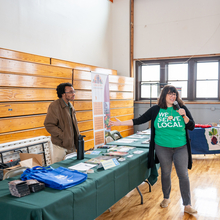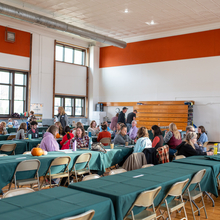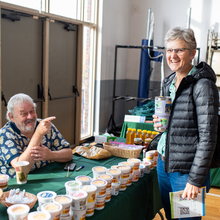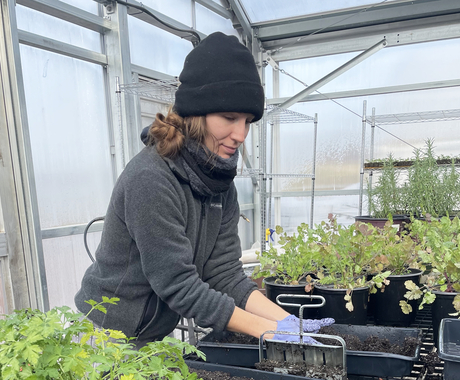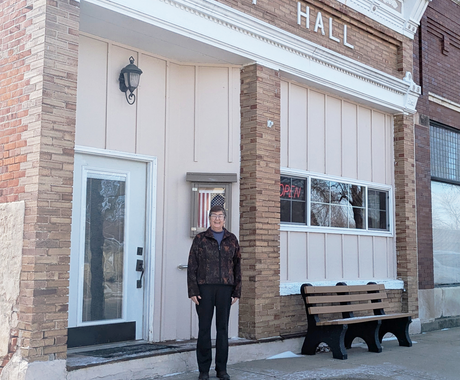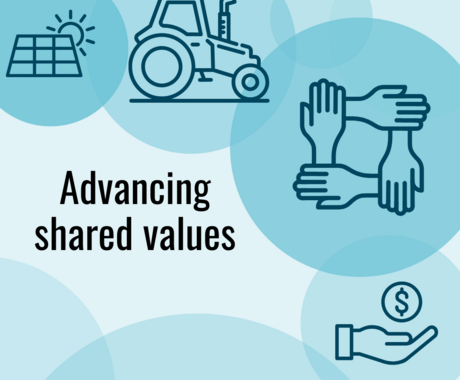Angelyn Wang contributed to this blog.
Local food, policy, and community gathering were top of mind for the second annual Local Foods Summit on Nov. 8 in Malvern, Iowa.
The summit was hosted by the Center for Rural Affairs and Golden Hills Resource Conservation and Development (RC&D) and focused on all aspects of local food and community.
Malvern was an ideal setting, with local businesses and the Liberty Memorial Community Center opening doors for the 100-plus attendees. Art Church Malvern and the Malvern Public Library also served as host sites for educational sessions. Classic Cafe on Malvern Main Street catered a delicious breakfast and lunch featuring greens grown at Sown Local Farm off of Main Street. Local farmers and producers brought their wares to share in the exhibitor space, including fresh vegetables, honey, and ceramic artwork.
A few of the one-day summit educational session speakers were Sophie Churchill with Iowa Valley RC&D, Michelle Dill with Farm Table Delivery, and Luke Elzinga with the Des Moines Area Religious Council Food Pantry Network. Farmers and local food producers who shared stories included Sandro Lopes, Krystal Hartmann, and Ali Yahnke. Of special note, Tom Mulholland, who is rebuilding Mulholland Grocery in Malvern, spoke on small town business resiliency.
Topics included regenerative farming, food systems advocacy, rural grocery models, and bringing together farmers markets, commercial kitchen, and community spaces. Sessions were offered in both English and Spanish. The Malvern Public Library also hosted kids sessions featuring local Malvern artist Anna Stoysich.
“We are so proud to be able to bring everyone together again for the summit,” said Angelyn Wang, local foods associate with the Center. “We had an amazing community and partner in Malvern. Presenters, exhibitors, and colleagues who are doing really great work in southwest Iowa around local foods took the time to share their knowledge. We were given a chance to build on the momentum from last year in this collaborative event.”
Attendees included local food producers, food service directors, teachers, local food advocates, community members, and many others engaging in the local foods sector. We asked a few of them their thoughts on local foods and on attending the summit.
Local food thoughts from attendees
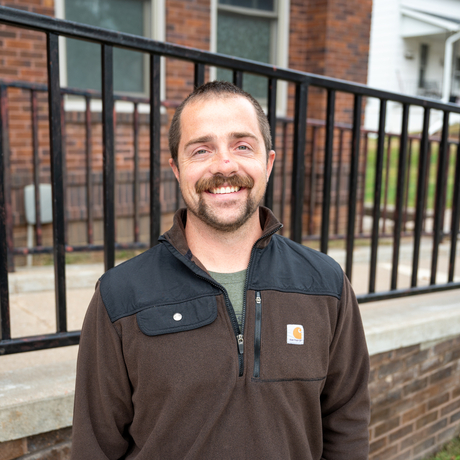
“I'm passionate about local foods and want to make connections with other people who produce and sell locally. I have aspirations to be an entrepreneur and do things around local foods, so it's good to make connections and talk with all the people and groups here.”
“In Iowa, we have all this valuable soil, and we're bringing in all this food from other places. Why are we not able to do this ourselves? You know, produce healthy food that supports our own members of our community.”
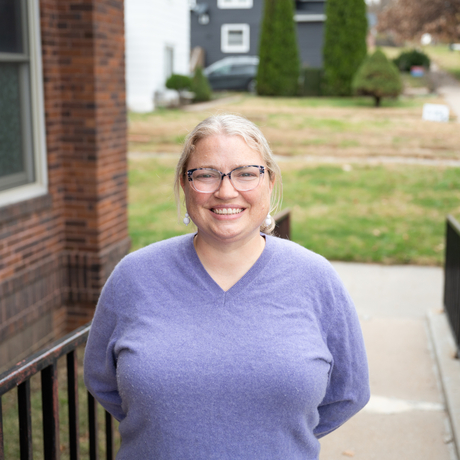
“I read a statistic that in Iowa, specifically, we import 90% of our food for humans. And that's a little bit crazy because we have so much farmland. I have space and I like to grow food, so I am excited about providing a little bit of food for my neighbors and changing that percentage.”
“I have nine apple trees and I have planted a few cherry trees. I'm trying to make a diverse orchard. Last year I started hundreds of pawpaws. I sell the fruit at farmer's markets and dry and sell apple chips. I also give a lot of fruit away.”
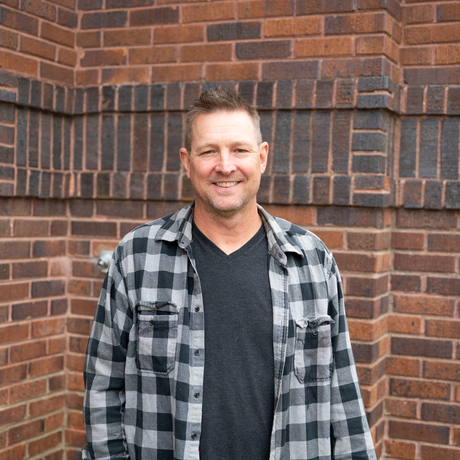
“I'm a small town advocate and full-time artist. There's a lot of similarities between being an artist and growing food, believe it or not. I'm primarily a painter of public art, murals, smaller oil paintings, commissions, that sort of thing.”
“Local foods are important to me because of quality; you know what you're getting. I've learned the term food desert, and we just don't have much of a selection for living in the Heartland and being able to have fresh lettuce or something that hasn't already been on the shelf or in the distribution. I grew up eating fresh fruit. I remember when a peach was juicy, and you go to a store now and you bite into a peach that has the texture of an apple. So, definitely there's a difference in taste.”
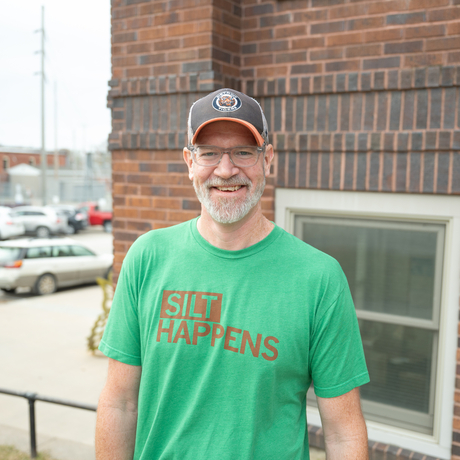
“When we first started farming it was to save on our grocery bills. I thought I could build a job for myself that I really wanted to do and do it the way I wanted—to grow organically and have clean, healthy food while helping the family business. We were worried about groceries and constantly fighting those bills and then through that process, it really opened my eyes to the school issues and the other food insecurity issues. Local food access is something I'm very passionate about and the fact that we can gather people and share ideas is a big gap that it is missing. This kind of community and sharing and people helping each other is needed and I love helping try to grow it.”

“I was really excited to be able to spend the day with people who are excited about real food.”
“Food is nourishing our bodies, but you also have to have things that are nourishing your soul. When I think about the food that I'm eating, I'm thinking about who grew it, who picked it, who washed it, who sent it to me, and how I got it; that's the nourishing part. When I'm eating a beautiful heirloom tomato that one of my fellow farmers grew, I'm thinking, ‘This is so good because Ali grew it, and it's part of her connection to the soil.’ That is real community.”
Click into each photo to enlarge. Photos by Kylie Kai.
Photo 1: Cynthia Farmer, Luke Elzinga, Tommy Hexter, Ilsa DeWald, and Kelsey Willardson serve on a Food Systems Advocacy Panel.
Photo 2: Zack Jones speaks about the Malvern community and his additions to the space, including the Art Church.
Photo 3: Several attendees making garden journals during a session.
Photo 4: Ali Yahnke gives a talk on farm stands in Malvern’s Art Church.
Photo 5: Anna Stoysich, an artist in Malvern, helps kids make crafts at the Malvern Public Library.
Photo 6: Attendees chat during an ice breaker.
Photo 7: Summit attendees ready for a day full of networking and learning about local foods.
Photo 8: Sandro Lopes speaks during his session, “A Journey to be a Regenerative Agriculture Farmer.”
Photo 9: Lisa Stewart, Chelsea Krist, and Sophie Churchill present during the “Scratch Cooking in Schools with Local Foods” session.
Photo 10: Deborah Solie introduces vendors during the summit’s opening session.
Photo 11: The Local Foods Summit was mostly held in Malvern’s Liberty Memorial Community Center.
Photo 12: Attendee visits a vendor booth offering honey products.

